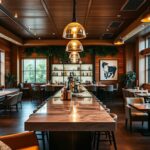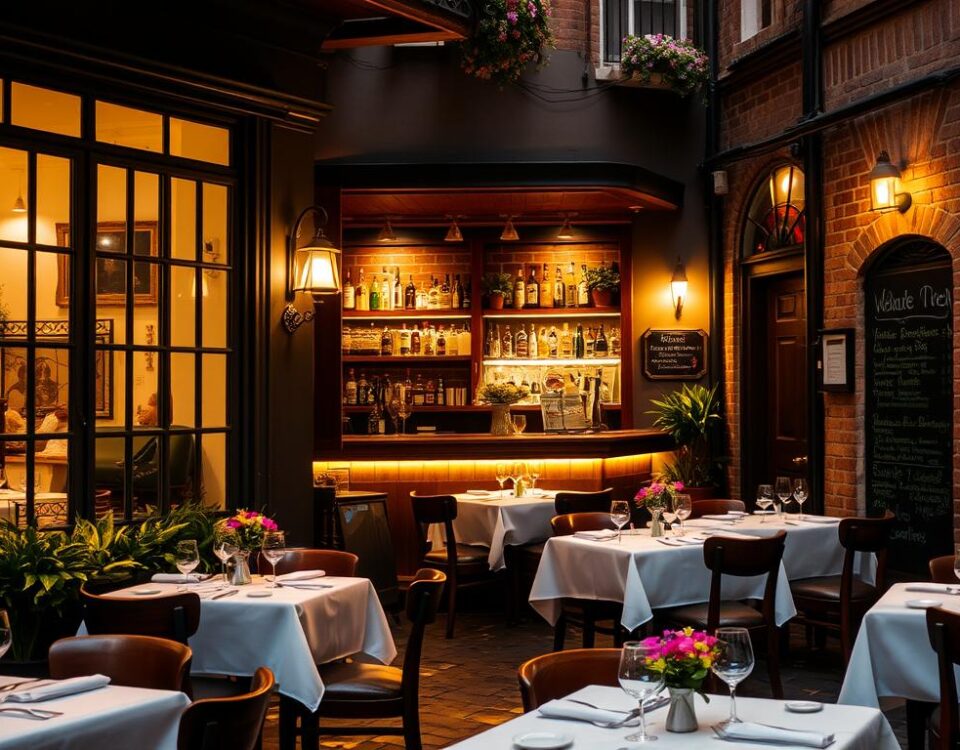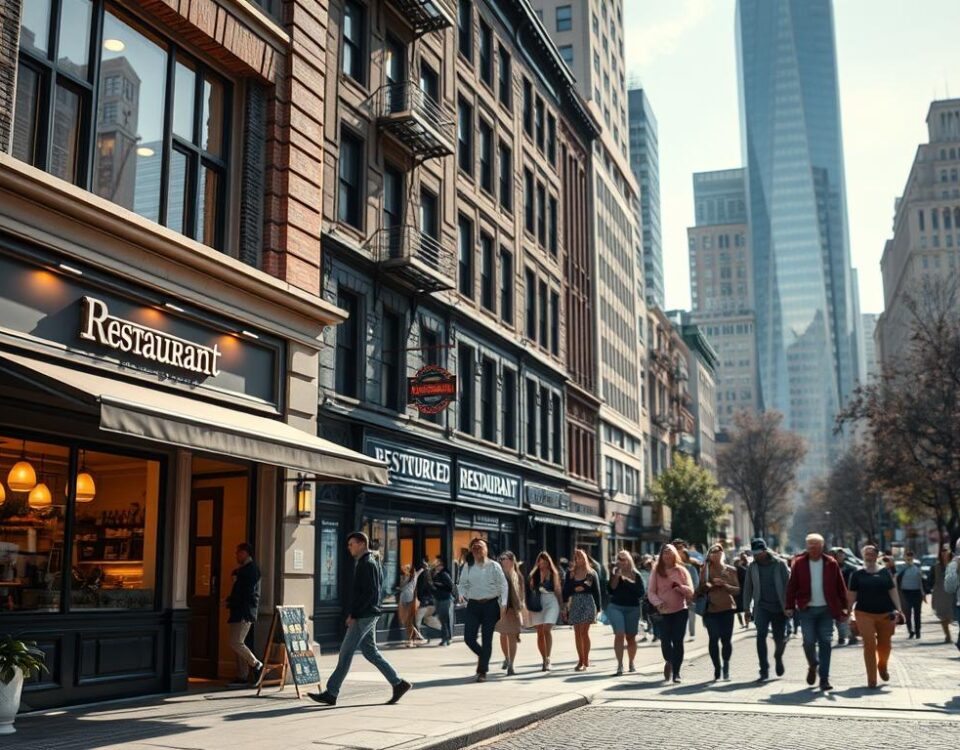
How to Design a Restaurant Experience That Gets 5-Star Reviews and Repeat Visits
October 31, 2025
How Upscale Restaurants Attract High-Spending Guests—And Keep Them Coming
November 1, 2025I still remember walking into a busy restaurant on a Friday night, the atmosphere buzzing with the right mix of music and lighting that made me want to stay longer and enjoy my meal. What if I told you that this carefully crafted ambiance wasn’t just a coincidence, but a science-backed strategy to boost sales?
Did you know that a staggering 79% of customers notice background music in restaurants? A global restaurant chain discovered that playing random hits led to a 4.3% drop in sales, while a curated mix of hits and lesser-known tracks resulted in a 9.1% sales jump. The right combination of music and lighting can significantly impact the dining experience.
As we explore the science behind ambiance, you’ll discover how to create an experience that keeps customers coming back. What if you could transform your restaurant into a haven that not only delights the palate but also boosts your bottom line?
Key Takeaways
- The right mix of music and lighting can significantly impact customer behavior and sales.
- A curated ambiance can make customers stay longer and spend more.
- Science-backed strategies can help restaurant owners create a memorable dining experience.
- The wrong music or lighting can negatively impact sales and customer satisfaction.
- A well-designed atmosphere can be a key differentiator for restaurants.
The Science Behind Ambiance and Restaurant Revenue
The science behind ambiance reveals that it’s not just about aesthetics; it’s about crafting an experience that drives sales. Research has shown that the environment of a restaurant significantly influences customer behavior and purchasing decisions.
How Environment Influences Customer Behavior
The environment of a restaurant plays a crucial role in shaping customer behavior. Sensory cues such as lighting, music, and décor trigger emotional and behavioral responses in customers. For instance, a well-lit dining area can create a welcoming atmosphere, while a dimly lit area can foster intimacy.
| Environmental Factor | Customer Response |
|---|---|
| Lighting | Influences mood and appetite |
| Music | Affects pace of dining and conversation |
| Décor | Creates ambiance and sets expectations |
The Bottom-Line Impact of Atmosphere
The atmosphere of a restaurant has a direct impact on its revenue. A well-designed atmosphere can increase customer satisfaction, leading to repeat business and positive word-of-mouth. Studies have shown that atmosphere can be more influential than food quality in determining customer satisfaction.
https://www.youtube.com/watch?v=Racf3HX_lrQ
By understanding how different elements of atmosphere work together, restaurant owners can create a cohesive dining experience that drives sales and boosts revenue.
The Proven Impact of Music on Restaurant Sales
Studies have proven that the right music can boost restaurant sales by creating a welcoming atmosphere for customers. The strategic use of background music in restaurants can significantly influence customer behavior, ultimately affecting sales figures.
Research-Backed Music Effects on Spending
Research indicates that music directly influences customer spending patterns in restaurants. The tempo, volume, and genre of music can create different psychological effects that can be strategically leveraged to enhance the dining experience. For instance, a study found that restaurants playing a mix of popular and niche music saw a 3.6% increase in sales compared to those playing only popular hits. Moreover, dessert sales soared by 15.6% when the right playlist was implemented.
| Music Type | Sales Impact |
|---|---|
| Popular & Niche Mix | +3.6% Sales |
| Dessert Sales with Right Playlist | +15.6% |
How Different Music Genres Affect Different Demographics
Different demographics respond uniquely to various music genres. For example, younger customers may prefer contemporary hits, while older patrons might enjoy classic melodies. Restaurants can tailor their playlists to match their target audience, enhancing the overall dining experience. By understanding the musical preferences of their customers, restaurants can create a more engaging atmosphere, encouraging longer stays and increased spending.

Creating the Perfect Restaurant Playlist
To maximize restaurant sales, it’s vital to craft a playlist that resonates with your target audience and complements your brand identity. Your ideal playlist depends on your brand, whether it’s a college hotspot thriving on upbeat indie or a retro diner that lives on nostalgic tunes.

Balancing Popular Hits with Brand-Aligned Tracks
A mix of familiar hits and lesser-known tracks creates the optimal listening experience for diners. This balance ensures that the music is engaging without overpowering conversation.
Tempo and Volume Considerations by Time of Day
The tempo and volume of your playlist should vary throughout different service periods to match customer energy and expectations. For instance, a more relaxed atmosphere during breakfast and a livelier vibe during dinner times.
Music Licensing Requirements for Restaurants
Playing background music in your restaurant requires proper licensing. Services like Soundtrack can help you get the right licensing for your restaurant’s music, ensuring you’re compliant with legal requirements.
By considering these factors and adjusting your playlist accordingly, you can enhance the dining experience and potentially increase sales. It’s also crucial to test and refine your playlist strategy based on customer feedback and sales data.
Strategic Lighting Design to Boost Restaurant Sales with Music and Lighting
Strategic lighting design is not just about visibility; it’s about crafting an atmosphere that resonates with customers and drives sales. The right ambiance sets the stage for an unforgettable dining experience that lingers in the minds of your guests long after they’ve left.
The Psychology of Light Intensity and Color Temperature
Lighting directly influences mood, appetite, and dining duration in restaurant settings. The science behind light intensity and color temperature reveals that different lighting levels can impact everything from food perception to spending habits. For instance, warm lighting can stimulate appetite, while cool lighting can enhance alertness.
| Lighting Type | Effect on Customers | Best Use |
|---|---|---|
| Warm Lighting | Stimulates appetite, creates cozy atmosphere | Dining areas, intimate settings |
| Cool Lighting | Enhances alertness, improves visibility | Bars, waiting areas |
Creating Zones with Different Lighting Purposes
Creating distinct lighting zones within your restaurant can serve different purposes and enhance the overall experience. This can include using lighting to highlight menu items, architectural features, and create Instagram-worthy moments. By balancing natural and artificial lighting effectively, restaurants can create a welcoming atmosphere that appeals to a wide range of customers.
By understanding the psychology of lighting and implementing strategic lighting design, restaurants can significantly boost sales and enhance the dining experience for their customers.
Practical Lighting Implementation Strategies

Restaurants can greatly benefit from adopting layered lighting approaches that cater to different dining experiences. Effective lighting can enhance the ambiance, making customers feel more comfortable and inclined to spend more.
Layered Lighting Approaches for Different Dining Experiences
A layered lighting approach involves combining ambient, accent, and task lighting to create a visually appealing atmosphere. For example, ambient lighting can be used to set the overall mood, while accent lighting highlights specific design elements or architectural features.
Lighting Control Systems Worth the Investment
Investing in a lighting control system can provide flexibility and efficiency in managing a restaurant’s lighting. These systems allow for adjustments based on the time of day, occupancy, and specific events, ensuring that the lighting is always optimized.
Natural vs. Artificial Light Considerations
Balancing natural and artificial light is crucial for creating a welcoming atmosphere. During the day, maximizing natural light can make the restaurant feel more inviting, while artificial lighting can be used to supplement natural light during the evening or in areas with limited natural light.
Synchronizing Music and Lighting for Maximum Impact
To create a truly immersive dining experience, synchronizing music and lighting is crucial. When both elements are aligned, they can significantly enhance the overall ambiance of your restaurant, leading to a more engaging experience for your customers.
Cohesive Sensory Experiences
Creating a cohesive sensory experience involves more than just playing background music and adjusting the lighting. It’s about crafting an atmosphere that complements your restaurant’s concept and enhances the dining experience. Collaborating with a professional music curation service can help align your music selections with your restaurant’s theme, contributing to a higher dining experience score.
Adjusting Both Elements Throughout Service Periods
Adjusting both music and lighting throughout different service periods is essential to match customer expectations and energy levels. For instance, during lunch service, a more upbeat tempo can encourage quick turnover, while a slower tempo during dinner service can promote lingering. A well-designed lighting system can also be adjusted to complement these changes, creating a seamless experience for your customers.
| Service Period | Music Tempo | Lighting Adjustment |
|---|---|---|
| Lunch | Upbeat | Brighter |
| Dinner | Slow | Dimmmer |

Customizing Ambiance for Your Restaurant Type
To stand out, restaurants need to tailor their ambiance to their brand and clientele. Every element, from lighting and music to furniture and décor, should work together to reflect the desired mood and enhance the dining experience.
Fast-Casual vs. Fine Dining Approaches
Different types of restaurants require distinct ambiance strategies. For instance, fast-casual establishments often benefit from bright, energetic lighting and upbeat music to create a lively atmosphere. In contrast, fine dining restaurants typically opt for softer, more subdued lighting and classical music to foster an intimate and sophisticated ambiance.

Themed Restaurant Considerations
Themed restaurants can leverage music and lighting to enhance their concept and create immersive experiences. For example, a tropical-themed restaurant might use bright colors, lively music, and warm lighting to transport customers to a beachy paradise. When balancing theme elements with practical considerations, it’s essential to ensure that the ambiance doesn’t compromise conversation comfort or food visibility.
Measuring the ROI of Your Ambiance Investments
Evaluating the ROI of ambiance investments is essential for making informed decisions about your restaurant’s atmosphere. To accurately measure the impact of ambiance changes, you need to track key metrics before and after implementation.
Key Metrics to Track Before and After Changes
To assess the effectiveness of ambiance changes, monitor your average check amounts and customer dwell time. Research has shown that an appealing ambiance can lead to a 9.1% sales lift. Track these metrics to understand how ambiance changes affect your restaurant’s sales.
| Metric | Before Changes | After Changes |
|---|---|---|
| Average Check Amount | $25.00 | $27.50 |
| Customer Dwell Time | 45 minutes | 60 minutes |
Customer Feedback Collection Methods
Collecting customer feedback is crucial to understanding the impact of ambiance changes on customer experience. Use online surveys, comment cards, or social media listening to gather feedback. Analyze online reviews to identify patterns in customer comments about your restaurant’s atmosphere.
By tracking key metrics and collecting customer feedback, you can refine your ambiance to improve customer satisfaction and drive sales.
Technology Solutions for Ambiance Management

The right technology can make a significant difference in managing a restaurant’s ambiance. Modern technology streamlines restaurant operations, enhances guest experience, and boosts sales. By leveraging technology, restaurant owners can create a more inviting atmosphere, improving customer satisfaction and loyalty.
Automated Scheduling Systems
Automated scheduling systems for music and lighting can adjust throughout the day without constant staff intervention. These systems allow for seamless transitions between different ambiance settings, ensuring a consistent customer experience. By automating routine tasks, staff can focus on providing excellent service.
Smart Integration with Other Systems
Smart integration with other restaurant systems, such as POS and reservation platforms, can create a cohesive experience. Centralized control systems enable managers to adjust ambiance elements from a single interface. This integration enhances operational efficiency and improves the overall dining experience.
Common Ambiance Mistakes That Drive Customers Away
When it comes to creating an inviting atmosphere, restaurants often make critical mistakes that drive customers away. The ambiance of a restaurant significantly influences customer behavior and spending habits. A well-designed ambiance can enhance the dining experience, while a poorly executed one can lead to customer dissatisfaction.
Music Pitfalls to Avoid
One of the most common music-related mistakes is poor sound quality. Poor sound quality, such as crackling, distortion, or rattling speakers, can ruin the dining experience. Investing in a high-quality business sound system is essential to ensure that the music enhances the ambiance. Additionally, using generic, thoughtless background music can be worse than having no music at all, as it fails to create a unique experience for customers.
Volume control is another critical aspect. Restaurants must find the right balance for different dining periods and layouts to avoid overwhelming or underwhelming customers.
Lighting Errors That Hurt Sales
Lighting mistakes can also significantly impact the dining experience. Inappropriate lighting can make food look unappetizing or create uncomfortable glare for diners. Restaurants should aim for a layered lighting approach that highlights different areas and creates a welcoming atmosphere. Avoiding harsh or dim lighting can help create a comfortable environment where customers feel at ease.
By being aware of these common ambiance mistakes, restaurants can take steps to create a more inviting atmosphere that enhances customer satisfaction and drives sales.
Real-World Success Stories: Before and After
Restaurants that have invested in ambiance improvements have seen remarkable results. By transforming their music and lighting, these establishments have not only enhanced customer experience but also boosted sales and revenue.
A Struggling Restaurant’s Transformation
A well-known casual dining chain revamped its interior design by upgrading to a warmer lighting decor color scheme and integrating soft seating. The result was a 12% increase in average customer spend and a noticeable rise in repeat visits.
Fine Dining Revenue Boost
One fine dining restaurant reimagined its space with a sophisticated look, incorporating lighting elements that paired natural light with accent fixtures. This led to an uplift in customer satisfaction scores and a measurable increase in willingness to pay premium prices.
- Significant increase in customer spend and satisfaction
- Notable rise in repeat visits and willingness to pay premium prices
Conclusion: Creating Your Ambiance Action Plan
The science is clear: a well-crafted ambiance can significantly boost restaurant sales and customer retention. To create an exceptional experience, restaurant owners must consider the impact of music and lighting on their customers.
To get started, assess your current ambiance and identify areas for improvement. Begin with high-impact, low-cost changes such as adjusting music tempo and lighting intensity. Ensure you’re playing music legally by obtaining proper licensing.
By following this action plan, you’ll be well on your way to creating an ambiance that drives sales and grows your business. Continuously refine your approach based on customer feedback and sales data to maximize your restaurant’s potential.
FAQ
How can I create an ambiance that encourages customers to stay longer and increase revenue?
To create an inviting atmosphere, consider synchronizing music and lighting to craft a cohesive sensory experience. Adjust both elements throughout service periods to keep the ambiance fresh and engaging.
What type of music is most effective for different demographics?
Research suggests that different music genres appeal to various age groups and demographics. For example, younger crowds often prefer contemporary hits, while older patrons may enjoy classic or nostalgic tunes.
How do I choose the right lighting for my restaurant?
The right lighting depends on the type of dining experience you’re creating. Consider the psychology of light intensity and color temperature to craft the desired atmosphere. For instance, warm tones can create a cozy feel, while cool tones can make a space feel more energetic.
Can background music really impact customer behavior?
Yes, background music can significantly influence customer behavior, including their willingness to linger over meals and make additional purchases. The right tempo and volume can also affect the overall dining experience.
How can I measure the effectiveness of my ambiance investments?
To gauge the success of your ambiance efforts, track key metrics such as customer loyalty, average table stay, and online reviews before and after making changes. Collecting customer feedback through surveys or comment cards can also provide valuable insights.
What are some common ambiance mistakes that can drive customers away?
Common pitfalls include using music that’s too loud or jarring, or lighting that’s too harsh or dim. Be mindful of these potential errors to create a welcoming atmosphere that keeps customers coming back.
Are there any technology solutions that can help me manage my ambiance?
Yes, automated scheduling systems for music and lighting can streamline ambiance management. You can also integrate these systems with other restaurant technologies to create a seamless experience.
How often should I update my ambiance to keep it fresh?
Regularly updating your ambiance can help keep the atmosphere feeling new and exciting. Consider making seasonal changes or adjusting your music and lighting to reflect different times of day or special events.



